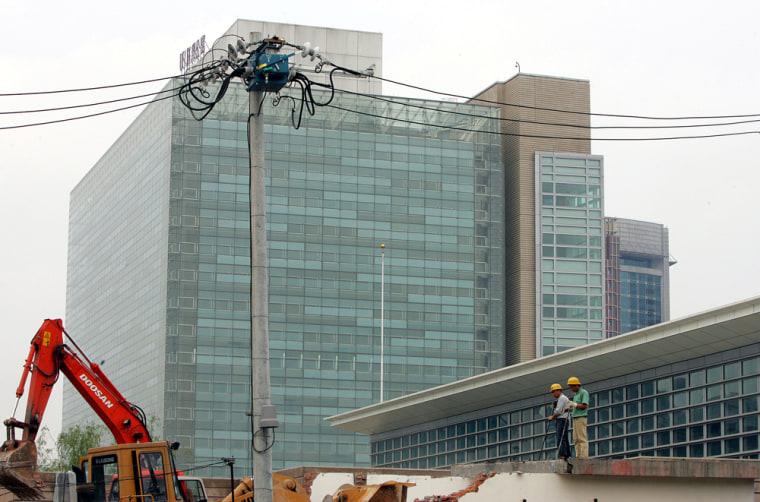A massive new U.S. Embassy, the second-largest in the world after the heavily fortified compound in Baghdad, formally opens in the Chinese capital this week, a testament to the depth and breadth of the ties binding the trading partners and sometimes rivals.
President Bush, who will be attending the Beijing Olympics opening ceremonies Friday, is to preside over the ribbon-cutting at the $434 million, 500,000-square-foot compound that same day. Embassy personnel will not move in until after the Olympics in case there are glitches in communications or other systems.
The eight-story main building, wrapped in an outer envelope of freestanding transparent and opaque glass, was designed with traditional Chinese elements in mind. Narrow walkways lined with bamboo link diplomatic "neighborhoods."
"The scale and size of this embassy — set on 10 acres in a new diplomatic zone — symbolizes the future of the relationship as it expands in scope and breadth," said Victor Cha, director of Asian studies at Georgetown University and author of a forthcoming book, "Beyond the Final Score: The Politics of Sport in Asia."
Under the Bush administration, the U.S. has had to engage a China in flux — a rapidly ascending power whose cooperation has become necessary in tackling numerous global issues such as nuclear nonproliferation and climate change, Cha said.
"The U.S. acknowledges China's place in the world," he said. "It acknowledges that China's rise is not a zero-sum game. ... That's not denying the competitive aspects to the relationship, but it is a broader template, which coincides with the building of the new embassy."
New China embassy is largest in U.S. capital
China unveiled its own imposing new embassy in Washington last week. The 250,000-square-foot glass and limestone compound, designed by I.M. Pei's two sons, is the largest foreign embassy in the U.S. capital.
"The completion of the two new embassies not only reflects the good shape of our relationship, but also signals broad prospects for its further growth," Foreign Minster Yang Jiechi said at the opening, according to the official Xinhua News Agency.
The bilateral relationship has taken "an extraordinary path" and stands at an "unprecedented level," Yang said.
The broadening of the relationship has more to do with China's emergence as an economic and political force than with U.S. policy, said Randall Schriver, who was deputy U.S. assistant secretary of state for East Asian and Pacific affairs from 2003 to 2005.
"A decade ago, the bilateral issues were relatively well-known: Taiwan, human rights, trade. Now, (China's interests) literally span the globe," he said.
China remained in the background in global affairs for two decades after its 1979 opening and the launch of economic reform. But over the past decade, Beijing influence has expanded with activities ranging from taking on a bigger role in U.N. peacekeeping to acting as host and a key player in international negotiations on North Korea's nuclear program.
In 1986, Joe Toussaint was first sent to Beijing to scope out a site for a new U.S. embassy. Bicycles filled the streets, and citizens dressed in monochrome gray, he recalled.
"You can imagine how different it was then," said Toussaint, managing director of project execution for the U.S. State Department's Bureau of Overseas Buildings Operations.
New embassy already too small
Fast forward more than two decades. The streets are jammed with cars, and high-rise construction projects dot a fast-changing skyline.
Lack of funding during most of the 1990s delayed plans for the new embassy, Toussaint said. However, following the deadly 1998 bombings at U.S. embassies in Kenya and Tanzania, the U.S. began to secure and upgrade embassies worldwide.
Violent protests outside the Beijing embassy after the U.S. bombed the Chinese Embassy in Belgrade in 1999 spurred plans to move the embassy to a safer location with a 100-foot security setback, Toussaint said.
The U.S. government insisted that the bombing by a B-2 stealth bomber was an accident — a claim Beijing rejected.
In 2000, the two countries started formal talks on reciprocal new embassies, he said.
The new U.S. embassy will have space for 700 staffers and more than 20 federal agencies. Having long outgrown its original space, the current embassy is spread out in more than a dozen locations across Beijing.
But the new embassy is already projected to be too small. Work will begin soon on a 70,000-square-foot annex for another 230 staffers and 10 more agencies.
